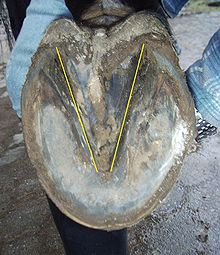Forced hoof
A compulsory hoof, or previously called heel compulsion, is a deformation of the hoof . The back of the hoof is too tight and causes pain for the horse when it touches down.
Symptoms
A forced hoof is immediately recognizable on the underside. The grooves form a V in a healthy hoof. In the forced hoof or forced heel, they are not straight, but narrow in the area of the corner struts. The hoof mechanism no longer works, but reverses. Instead of the rear area of the hoof becoming wider when it is footed, it becomes narrower with the forced hoof. This causes pain to the horse.
causes
One cause of forced hooves is neglect. If the hoof becomes too long, in horses that are kept on ground that causes too little horn abrasion, then the high horn wall tends to become unstable. In some cases it bends outward, in the forced hoof it bends inward. A steep hoof position favors the formation of forced hooves, a flat one, on the other hand, the formation of heels pushed under .
Faulty shoeing with shoes that are too narrow can also make the hooves tighter. The back of the shoes must be wide enough for the hoof, which has been expanded by the hoof mechanism, to fit on the shoe.
Course of the disease and possible consequences
If a forced hoof continues to develop unhindered, this has two main consequences:
- A forced hoof causes pain, the horse hurts to walk, a forced hoof can lead to lameness and ensure that the horse can no longer work or becomes unrideable.
- The consequence that usually starts earlier is thrush . The forced hoof squeezes the middle furrow in such a way that a pocket is formed in which putrefactive bacteria can do their work of destruction without hindrance. If the soft ray horn decomposes down to the hoof dermis, then the dermis tries to produce horn faster than it is eaten away by the rot. But this quickly produced horn is of poor quality and will be eaten away faster because it is more sensitive to putrefaction. Ultimately, the horn begins to proliferate in an uncontrolled manner and the dermis becomes inflamed. The soft whitish horn produced by the inflamed dermis is ray cancer. If the inflammation spreads to the areas of the dermis that produce hard horn, the cancer of the ray turns into hoof cancer.
Regular observation and professional trimming of the hoof is recommended for prevention.
treatment
Optimization of housing conditions. The hoof must not become too long, the correct treatment of the hoof is important.
Remarks
- ↑ The heels form the rear part of the horn wall of the hoof.

